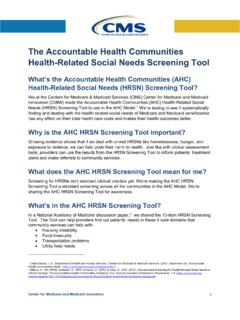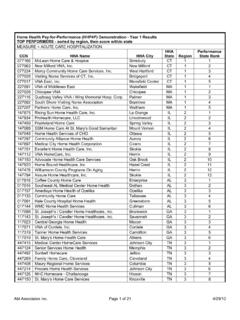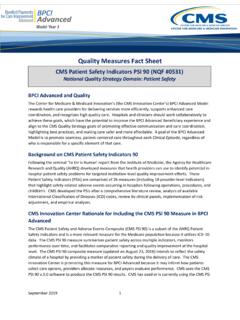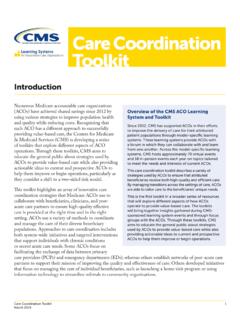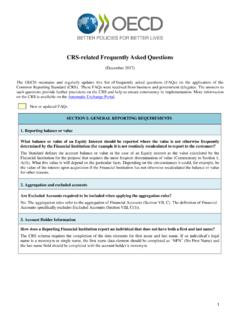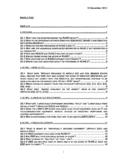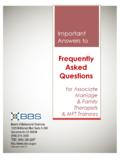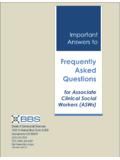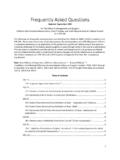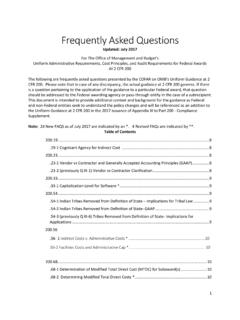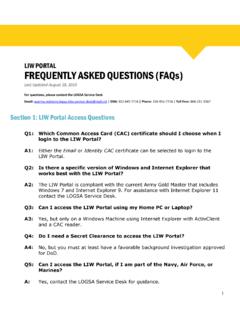Transcription of General Model Questions
1 Next Generation ACO Model : frequently asked Questions April 2019 General Model Questions 1. How does the Next Generation ACO Model ( the Model ) differ from the Medicare Shared Savings Program? A. The Next Generation ACO Model is distinct from the Medicare Shared Savings Program in a number of ways. The Model offers financial arrangements with higher levels of risk and reward, using refined benchmarking methods that reward both attainment of and improvement in cost containment. The Model also offers a selection of payment mechanisms to enable a graduation from fee-for-service (FFS) payment to all -inclusive population-based payments (AIPBP). Central to the Next Generation ACO Model are several benefit enhancement tools to help ACOs improve engagement with beneficiaries, such as: (1) greater access to home visits, telehealth services (asynchronous and synchronous), skilled nursing facility services, chronic disease management reward , and cost sharing support; (2) a process that allows beneficiaries to confirm their care relationship with ACO providers; and (3) greater collaboration between CMS and ACOs to improve communication with beneficiaries about the characteristics and potential benefits of ACOs in relation to their care.
2 2. How is an ACO different from Medicare Advantage (MA)? A. A Medicare Advantage (MA) plan is another way for a Medicare beneficiary to get Medicare coverage, namely through a private insurer that has been approved by and has a contract with Medicare. ACOs, on the other hand, are groups of providers that serve Original Medicare beneficiaries. All of CMS s ACO models are part of the Original Medicare Program and generally follow Original Medicare rules and processes, and beneficiaries aligned to ACOs have freedom of choice to go to the Original Medicare providers and suppliers of their choice, as opposed to the defined provider network of an MA plan. There is no requirement that a beneficiary receive services from an ACO, nor is there additional premium paid by the beneficiary for being aligned to an ACO. In addition, beneficiaries aligned to Next Generation ACOs maintain all Original Medicare benefits.
3 Beneficiaries who are aligned to an ACO also may receive certain benefit enhancements , but are not penalized in any way for seeing non-ACO providers. The Next Generation ACO Model does not require beneficiary enrollment. Beneficiaries are aligned to ACOs through claims or through voluntary alignment, when beneficiaries confirm a care relationship with a health care provider participating in the ACO. 3. How did CMS select participants for the Model ? A. CMS evaluated applications in accordance with specific criteria in five key domains: (1) organizational structure; (2) leadership and management; (3) financial plan and experience with risk sharing; (4) patient centeredness; and (5) clinical care Model . 2 These domains and associated point scores are detailed in Appendix F of the RFA. In addition, we considered whether applicants had demonstrated that their organizational structures promote the goals of the Model by including diverse sets of providers and suppliers who would demonstrate a commitment to high quality care.
4 Lastly, applicants with prior participation in a CMS program or demonstration were asked to demonstrate good performance and conduct in the previous initiative. CMS accepted applicants for participation beginning in 2016, 2017, and 2018 but does not currently plan to open the Model to additional applicants. 4. May the ACO communicate to patients about its Next Generation participants who they are and why the ACO has selected them? A. The Next Generation ACO Model has specific terms and guidelines regarding communications with beneficiaries, but CMS supports the dissemination by ACOs of information identifying all providers and suppliers associated with the ACO. Beneficiary awareness of and engagement with ACO-directed care is a central component of the Model . 5. When did this Model start? A. The Next Generation ACO Model began in 2016. New cohorts of ACOs began participating in the Model in each of 2017 and 2018.
5 In the NGACO Model , 2016 is often referred to as Performance Year 1 (PY1), 2017 is referred to as Performance Year 2 (PY2) and 2018 is referred to as Performance Year 3 (PY3). The Next Generation ACO Model began testing new benefit enhancements and an updated financial methodology for 2019 and 2020, which are often referred to as Performance Year 4 (PY4) and Performance Year 5 (PY5), respectively. 6. Is this a capitated ACO Model ? A. Beginning in PY2 (2017), Next Generation ACOs have had the option to participate in a capitation-like payment mechanism, called All-Inclusive Population-Based Payments (AIPBP). AIPBP is one of three available alternative payment mechanisms from which the ACOs can select. AIPBP in the Next Generation ACO Model is a payment mechanism, which is distinct from the risk arrangement that the ACO selects. All ACO benchmarks are calculated the same way, independent of the alternative payment mechanism and risk arrangement an ACO selects.
6 AIPBP functions by estimating total annual expenditures for care furnished to aligned beneficiaries by AIPBP-participating providers and suppliers and paying that projected amount to the ACO in a monthly AIPBP payment. Medicare then makes a corresponding 100% reduction in Medicare FFS payments to these providers and suppliers, called the AIPBP Fee Reduction. Next Generation ACOs that participate in AIPBP are responsible for paying claims for their AIPBP-participating Next Generation Participants and Preferred Providers with whom the ACO has written arrangements regarding AIPBP. The difference between the monthly AIPBP amounts paid to the ACO and the AIPBP Fee Reduction is reconciled each year. 7. What happens if the projected trend used in calculating the performance year benchmark is higher or lower than the experienced trend? A. Under limited circumstances, CMS may retroactively adjust the projected trend used in calculating the performance year benchmark if CMS determines that unforeseen events have occurred during the performance year that have rendered the projected trend invalid for purposes of assessing the expected level of Medicare FFS spending.
7 Trend 3 adjustments are intended to prevent ACOs from being unfairly penalized or rewarded for major payment changes beyond their control. The terms and conditions for trend adjustments in this Model are established in the Next Generation ACO Model Participation Agreement. 8. How does this Model address concerns that high turnover in beneficiary alignment may hamper the effectiveness of care interventions and thus limit the gains for these investments? A. The Next Generation ACO Model seeks to mitigate fluctuations in the aligned beneficiary population and respect beneficiary preferences by supplementing claims-based alignment with voluntary alignment. Under voluntary alignment, Next Generation ACOs may offer beneficiaries the option to confirm or deny their care relationships with specific Next Generation Participants. This beneficiary input will be reflected in alignment for the subsequent performance year ( , during PY4 (2019) , beneficiaries can confirm relationships that affect alignment for PY5 (2020), provided such beneficiaries meet all applicable eligibility criteria).
8 Confirmations of care relationships through voluntary alignment supersede claims-based attributions. For example, a beneficiary who indicates that a Next Generation Participant is her main source of care may be aligned with the ACO, even if claims-based alignment would not result in alignment. This enables more alignment continuity across performance years. 9. In this Model , when ACOs take accountability for the total cost of care, do beneficiaries still have open access, as with Original Medicare? A. Yes. A core principle of the Next Generation ACO Model is to protect Original Medicare fee-for-service (FFS) beneficiaries freedom to seek the services and health care providers of their choice. Beneficiaries retain full freedom of choice of providers and suppliers, as well as all rights and beneficiary protections of Original Medicare. The Next Generation ACO Model seeks to help providers and suppliers engage beneficiaries in their care through benefit enhancements that are intended to reduce program costs and directly improve quality of care and the patient experience.
9 The Next Generation ACO Model also permits ACOs to designate Preferred Providers, in order to allow ACOs to establish relationships with providers and suppliers along the care continuum that emphasize high-value services and management of beneficiaries care. 10. My ACO is interested in benefit enhancements, but we did not implement some or any in our first years in the Model . Can we elect to participate in later years? A. Next Generation ACOs do not have to participate in any of the benefit enhancements in any given performance year. ACOs may elect to participate in each of the benefit enhancements on an annual basis. An ACO may choose not to .implement any or all of the offered benefit enhancements. Applicants were asked Questions specific to their proposed implementation of these benefit enhancements, but acceptance into the Next Generation ACO Model was not contingent upon an ACO implementing any particular benefit enhancement.
10 Specific terms and conditions for participation in the benefit enhancements are in the Next Generation ACO Model Participation Agreement. 11. What benefit enhancements are available for Next Generation ACOs? A. Next Generation ACOs could elect to participate in three benefit enhancements in PY1 4 (2016) and PY2 (2017), including a waiver of the three-day skilled nursing facility rule; coverage for telehealth services furnished in non-Health Professional Shortage Areas and at the beneficiary s place of residence; and allowing auxiliary personnel ( , licensed clinicians) to perform incident to post-discharge home visit services under the General supervision of a Next Generation Participant or Preferred Provider two times in a 30-day period. Beginning in PY3 (2018), the telehealth benefit enhancement included asynchronous ( , store and forward) coverage of teledermatology and teleophthalmology services.
